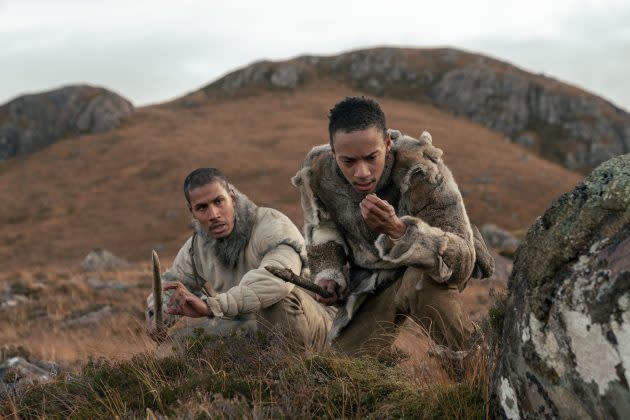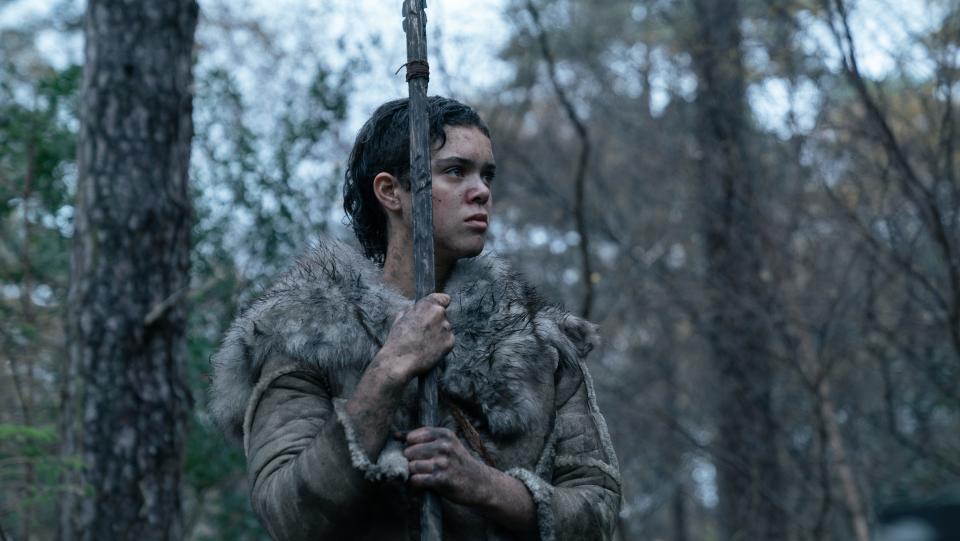‘Out of Darkness’ Director Explains the Film’s Shocking Twist and How He Made a Stone Age Horror in a Fake Language

SPOILER ALERT: This story contains spoilers for “Out of Darkness,” now playing in theaters.
About an hour into “Out of Darkness,” an Old Stone Age monster movie from first-time feature director Andrew Cumming, comes a shocking reveal: It’s not a monster movie at all.
More from Variety
The film, released in theaters Feb. 9, follows a tribe of people living on a desolate Scottish island 45,000 years ago who find themselves prey to a mysterious enemy that picks them off one by one. When 11-year-old Heron suddenly vanishes into the night, the tribe ventures into the forest to find him. Taking a page from “Jaws” and “Alien,” Cumming restrained himself from showing the antagonist until it became absolutely necessary, when it’s finally revealed that the menacing beast that’s hunting the tribe turns out to be human.
More specifically, it’s a pair of Neanderthals, who coexisted with Homo sapiens in Western Europe for several thousand years before going extinct. As the film unfolds, the Neanderthals’ intentions are revealed to be more complicated than initially presented. And by making the enemy look quite similar to the hero, Cumming muddies the dynamic between predator and prey, ultimately lending to a more devastating third act.
“The film is about fear,” Cumming says. “A real fear. Fear of a demon or monster or saber-toothed tiger stalking you. But I wanted the last third of the film to be, Now we know what this thing is. We know we can kill it. And if we can’t kill it, we’re going to die.”
Not everyone was thrilled about the ending, evident in the fact that before I ask my first question, Cumming admits to making the “mistake” of reading negative reviews.
“I went to Letterboxd and people were like, ‘This movie sucked! I wanted it to be a monster movie,'” the director says. “If you’re a certain type of horror aficionado and the first two-thirds of this movie is a monster movie, I can understand you’d feel short-changed. But I hope people can take a step back and think about what happens after the second act reveal and take the movie at face value… I think it’s a really powerful message.”
It’s a timeless message, Cumming adds, symbolic of the fact that “Out of Darkness” was conceived during the early stages of the pandemic, when fear seemed to swallow whatever trust people had in each other.
“If the words ‘45,000 Years Ago’ didn’t appear at the start of the movie, this could be the future,” he insists. “It could be some post-apocalyptic world where people are scrambling for survival and still making the same mistakes.”

In a bold move for a debut film, “Out of Darkness” is acted in an entirely made-up language called “Tola,” which stands for “The Origin Language.” It’s a loose mixture of Arabic and Basque invented by the multi-linguist academic Daniel Andersson, who “disappeared with the script for four weeks and came back with a fully fledged language,” says Cumming.
The director was, at one point, tempted to shoot the film in English because he was “worried about alienating the audience with subtitles,” but fought the urge because, “I didn’t want to be a lazy director. I wanted to fully commit to this world we were trying to create.”
After Andersson rewrote the script in Tola, Cumming worked with the actors on immersing in the language and nailing its “musicality,” tweaking certain sounds and mannerisms when necessary.
“Directing it [in Tola] was really liberating. You’re not getting caught up in the minutiae of the English language,” Cumming says, emphasizing that he and the cast were far from fluent in the film’s dialect. “I knew 85-90% of where they were at any point in the scene. But being able to look into the actors’ eyes and ask myself, ‘Do I believe this?’ — that’s where you want to get. Not only as a director but as an actor. Where the words are kind of superfluous to the intent of the scene.”
The film boasts breakout performances from Safia Oakley-Green (playing Beyah, the hardened young warrior whose menstruation leads the men in her tribe to blame her for their misfortunes), Kit Young (as the compassionate and weak-stomached Geirr) and Luna Mwezi (who shaved her head to transform into Heron). Mwezi impressed the filmmaking team so much that they decided she was the only actor who could play the tribe’s youngest boy, regardless of gender.
“Out of Darkness” is a brisk 87 minutes, but there’s a lot to be said about the movie. (Whatever Cumming can’t get to in our 30-some minutes over Zoom is surely printed in the film’s 29 pages of press notes.)
“I love ‘Killers of the Flower Moon,’ but three and a half hours for anything is a big commitment, and we’ve got busy lives,” Cumming says of the runtime debate. “I like when a film can have a beginning, middle and end that just does what it needs to do and gets out.”
Touché, Andrew.
Best of Variety
Sign up for Variety’s Newsletter. For the latest news, follow us on Facebook, Twitter, and Instagram.

